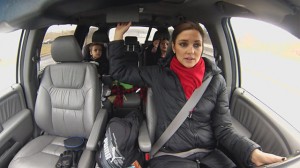
When we talk about distracted driving, the discussion often centers on the use of phones while behind the wheel. But what if carmakers and phone companies come together to make cars that do everything your smartphone does and more — making them “smartphones on four wheels.” Would the number of distracted driving accidents rise or fall?
That question has to be a top concern for automakers and phone companies as we head toward a future of connected cars.
AT&T’s Drive Studio
Recently, communications giant AT&T opened the doors on its Drive Studio, a 5,000+ square foot facility in Atlanta where carmakers can work with the phone company to create wired cars of the future.
For AT&T, it’s a chance to capitalize on a future market. Also, it is an open invitation to carmakers to test advances at a minimal cost to themselves. As CNET reports, it’s a “potentially lucrative” new business that would result in billions in revenue down the line.
Drive Studio will allow carmakers to bring in their vehicles to test or build connected cars from the ground up. An AT&T representative called it a place to go tear a car apart and replace and test new options.
While eating or reaching into the backseat to grab a toy for your child is enough to cause a fatal car accident, one can only imagine how ordering your dinner online or searching for the latest new movie to stream could affect your driving.
AT&T’s Drive platform seeks to turn cars into smartphones of the future. Drivers would be able to keep their phones in their pocket because their vehicles would do everything the handheld phone can do and more. The temptation for drivers to look away from the road to text, dial or get directions would be all but eliminated.
Driving the Car of the Future
AT&T sees future cars as carrying 4G LTE connectivity, allowing passengers to surf the Web or stream videos. Drivers could connect to Internet radio or search for the closest Thai restaurant without taking their eyes off the road.
Vehicle diagnostics could identify problems before they happened and then alert the driver and a mechanic simultaneously. Drivers could use technology to stop a car thief, warm-up the car on a cold day, or find where they parked at the mall.
Ideally, according to AT&Ts plan, automakers would be able to pick and choose the options they would offer in their vehicles. A vehicle might come loaded with the diagnostic software capabilities and safety systems, but a driver would have to go through AT&T for optional entertainment and additional services.
Safety must be at the forefront of this movement to design the cars of the future. Because technology moves light years faster than the legislative process, we will likely run into some safety issues as these vehicles hit the roads in the next several years.
